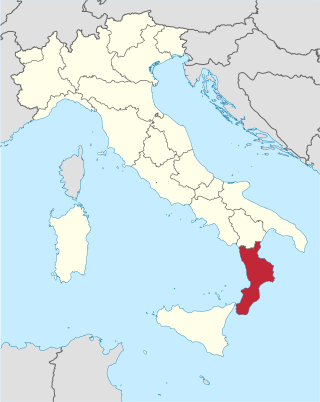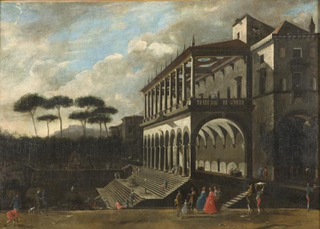Related Research Articles

Calabria is a region in Southern Italy. It is a peninsula bordered by Basilicata to the north, the Ionian Sea to the east, the Strait of Messina to the southwest, which separates it from Sicily, and the Tyrrhenian Sea to the west. It has almost 2 million residents across a total area of 15,222 km2 (5,877 sq mi). Catanzaro is the region's capital.

Reggio di Calabria, commonly and officially referred to as Reggio Calabria, or simply Reggio by its inhabitants, is the largest city in Calabria as well as the seat of the Regional Council of Calabria. It has an estimated population between 150,000 and 200,000 and is the twenty-first most populous city in Italy, after Modena and other Italian cities, and the 100th most populated city in Europe. Reggio Calabria is located near the center of the Mediterranean and is known for its climate, ethnic and cultural diversity. It is the third economic centre of mainland Southern Italy. About 560,000 people live in the metropolitan area, recognised in 2015 by Italy as a metropolitan city. Sadly, it holds the record of the worst city in terms of quality of life for environmental and cultural parameters, ranking among the worst Italian cities for quality of life.

Magna Graecia is a term that was used for the Greek-speaking areas of Southern Italy, in the present-day Italian regions of Calabria, Apulia, Basilicata, Campania and Sicily; these regions were extensively populated by Greek settlers starting from the 8th century BC.

Ferrara is a city and comune (municipality) in Emilia-Romagna, Northern Italy, capital of the province of Ferrara. As of 2016, it had 132,009 inhabitants. It is situated 44 kilometres northeast of Bologna, on the Po di Volano, a branch channel of the main stream of the Po River, located 5 km north. The town has broad streets and numerous palaces dating from the Renaissance, when it hosted the court of the House of Este. For its beauty and cultural importance, it has been designated by UNESCO as a World Heritage Site.

The Bruttians were an ancient Italic people. They inhabited the southern extremity of Italy, from the frontiers of Lucania to the Sicilian Straits and the promontory of Leucopetra. This roughly corresponds to the modern region of Calabria.

The Sicilians, or Sicilian people, are a Romance-speaking European ethnic group who are indigenous to the island of Sicily, the largest island in the Mediterranean, as well as the largest and most populous of the autonomous regions of Italy.

The Expedition of the Thousand was an event of the unification of Italy that took place in 1860. A corps of volunteers led by Giuseppe Garibaldi sailed from Quarto al Mare near Genoa and landed in Marsala, Sicily, in order to conquer the Kingdom of the Two Sicilies, ruled by the Spanish House of Bourbon-Two Sicilies. The name of the expedition derives from the initial number of participants, which was around 1,000 people.

The House of Piccolomini is the name of an Italian noble family, Patricians of Siena, who were prominent from the beginning of the 13th century until the 18th century. The family achieved the recognized titles of Pope of the Catholic Church, Prince of the Holy Roman Empire, Grandee of Spain, and Duke of Amalfi. The family is also featured in Florentine Histories, a book written by Niccolò Machiavelli, where he describes the reign of Pope Pius II, who had allied himself with the Venetians and Prince Vlad Dracula, to wage a war against the Sultan of the Ottoman empire.
The Oenotrians or Enotrians were an ancient Italic people who inhabited a territory in Southern Italy from Paestum to southern Calabria. By the sixth century BC, the Oenotrians had been absorbed into other Italic tribes.

Fagnano Castello is a town and comune in the province of Cosenza in the Calabria region of southern Italy. Fagnano Castello is located on Mount Caloria, part of the Coastal mountain range of Calabria, about an hour north of Cosenza.

Refrontolo is a comune (municipality) in the Province of Treviso in the Italian region Veneto, located about 50 kilometres north of Venice and about 30 km (19 mi) north of Treviso, representing the third smallest municipality by number of inhabitants (1,732) in the province, preceded only by Portobuffolé and Monfumo. It is located in a hilly viewpoint between Quartier del Piave and Montello, and it is crossed by the Prosecco and Conegliano-Valdobbiadene Hills Wine Road established in 1966. The municipality is in fact famous for the production of the Marzemino wine. Since July 7, 2019, Refrontolo's hills have been inscribed as an UNESCO World Heritage Site as The Prosecco Hills of Conegliano and Valdobbiadene.

Polistena is a comune (municipality) in the Metropolitan City of Reggio Calabria in the Italian region Calabria, located about 70 kilometres (43 mi) southwest of Catanzaro and about 50 kilometres (31 mi) northeast of Reggio Calabria.

San Giorgio Morgeto is a comune (municipality) in the Province of Reggio Calabria in the Italian region Calabria, located about 70 kilometres southwest of Catanzaro and about 50 km (31 mi) northeast of Reggio Calabria. As of 31 December 2004, it had a population of 3,356 and an area of 35.1 square kilometres (13.6 sq mi).

The etymology of the name of Italy has been the subject of reconstructions by linguists and historians. Considerations extraneous to the specifically linguistic reconstruction of the name have formed a rich corpus of solutions that are either associated with legend or in any case strongly problematic.

The Griko people, also known as Grecanici in Calabria, are an ethnic Greek community of Southern Italy. They are found principally in the regions of Calabria and Apulia. The Griko are believed to be remnants of the once large Ancient and Medieval Greek communities of Southern Italy, although there is some dispute among scholars as to whether the Griko community is directly descended from Ancient Greeks, from more recent medieval migrations during the Byzantine period, or a combination of both.

The Poggio Reale villa or Villa Poggio Reale was an Italian Renaissance villa commissioned in 1487 by Alfonso II of Naples as a royal summer residence. The Italian phrase "poggio reale" translates to "royal hill" in English. The villa was designed and built by Giuliano da Maiano and located in the city of Naples, in the district now known as Poggioreale, between the present Via del Campo, Via Santa Maria del Pianto and the new and old Via Poggioreale. At the time it was built, a period when the capital city of the Kingdom of Naples was renowned for elegant homes with expansive vistas of the surrounding landscape and Mount Vesuvius, the villa was outside the city walls of Naples and was one of the most important architectural achievements of the Neapolitan Renaissance. Imitated, admired, robbed of its treasures by another king, left in ruins and partially destroyed, the summer palace of the King of Naples lives on in name as a style.
The following is a timeline of the history of the city of Reggio Calabria, Italy.

The Ceva Grimaldi are an Italian noble family established in Southern Italy since the 16th century but whose origins are in Piedmont and Liguria and date back to the 10th century. The main titles associated with this branch of the Ceva family are Marchese di Pietracatella and Duca di Telese.
References
- ↑ "Dictionary of Greek and Roman Geography (1854), BRU´TTII".
- ↑ Girolamo Marafioti, Croniche et antichità di Calabria. Conforme all'ordine de' testi greco, & latino, raccolte da' più famosi scrittori antichi, & moderni ..., Padova, Ad instanza de gl'Uniti, 1601, p. 21. Ristampa anastatica: editore Arnaldo Forni, 1975 e 1981. Consultabile on line in Google Libri
- ↑ De Juliis , p. 22.
- ↑ Giacomo Devoto. Gli antichi Italici. Firenze, Vallecchi, 1977, p. 70.
- ↑ "Dictionary of Greek and Roman Geography (1854), OAENEUM, OENO´TRIA". www.perseus.tufts.edu. Retrieved 2022-01-01.
- ↑ Luigi Pareti (1997). "I "Primi Italici"". In Angelo Russi (ed.). Storia della regione lucano-bruzzia nell'antichità. Ed. di Storia e Letteratura. pp. 41–42. ISBN 978-88-6372-346-5.
- ↑ Rivista storica dell'antichità. 32. Pàtron Editore: 48. 2002.
{{cite journal}}: Missing or empty|title=(help) - ↑ Rivista storica dell'antichità. 32. Pàtron Editore: 53 & 57. 2002.
{{cite journal}}: Missing or empty|title=(help) - ↑ Girolamo Marafioti pag.114, Padova, Ad instanza de gl'Uniti, 1601. Ristampa anastatica: editore Arnaldo Forni, 1975 e 1981. Consultabile on line in Google Libri
- ↑ STORIA - Università degli Studi di Polistena
- ↑ Giovanni Fiore da Cropani ne "La Calabria Illustrata" (I tomo, 1691: l' opera integrale, in tre tomi, e stata pubblicata presso Rubbettino a cura di Ulderico Nisticò)
- ↑ "La notte Morgezia" (pubblicato a Napoli nel 1842) del canonico Nicolino Amendolia, in cui il prete racconta, con un sentimento di angoscia e di terrore l'incontro fatto al castello con il re guerriero Morgete.
- ↑ Domenico Cangemi, autore di una "Monografia di San Giorgio Morgeto" (1886)
- ↑ Strabo 6.257 & 270)